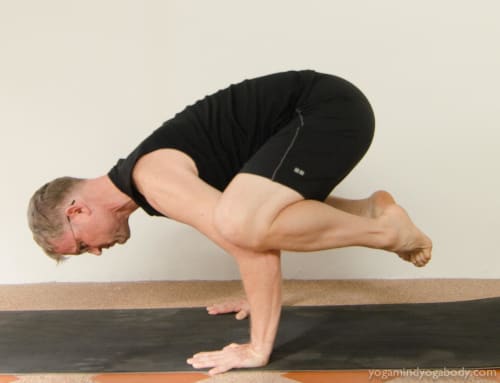You have probably heard a yoga teacher say something like “come to your edge, but don’t overstep it”. The place that is usually called “the edge” is the point along the stretch continuum beyond which you are in danger of injuring yourself, and beyond which your awareness deteriorates into an obsessive focus on whatever body part is experiencing the greatest intensity. Using yoga teacher Erich Schiffmann’s terminology, I want to refine this concept by calling this place your maximum edge, and talk about another place along the stretch continuum, your minimum edge, which is the place where you first feel a stretch. Becoming aware of your minimum edge will help you come into poses more mindfully, more slowly, and more deeply, and will reduce your chance of injury at the same time.
This week I want you to focus on pausing at your minimum edge as you come into each pose, pausing at the place where you just begin to feel a stretch. Finding your minimum edge is a real challenge, as the first inkling of a stretch sensation is a very subtle feeling. But by attuning yourself to this place, you can’t help but heighten your self-awareness, and become more present in the moment.
When you come to your minimum edge, pause, become aware of your breath, observe your alignment, and allow your energy to flow freely. Wait for the sensation of stretching to diminish before moving gradually deeper into the pose. You work from your minimum to your maximum edge using your breath, engaging muscles as you inhale, but also releasing tension and lengthening other muscles as you exhale. Move into each yoga pose mindfully and skillfully, balancing effort and surrender.
Let the overall sensation of moving into a pose be one of being drawn into the pose, rather than rushing into it. This way of moving requires full presence in the moment, and patience. It also requires that you enjoy yourself, and that you are interested in what you are doing. When you push too hard, too fast, you not only risk injury, you also miss the point of doing yoga in the first place, which is to increase awareness and serenity, and ultimately, happiness.
Try it now: Props are very useful for finding your minimum edge in many poses, especially ones where the weight is in part supported by one or both hands, or where the hand is “supposed” to reach the foot. Find a yoga strap or buckle 2 belts together to make one long one. Lie on your back and draw your right knee into your chest. Place the middle of the strap around the middle of the right foot, and then fully extend the leg forward, with the foot perhaps 30 cm (1 foot) off the floor. Hold the ends of the strap in one hand, supporting the leg near horizontal. Notice the tendency to lift the leg straight up, which would immediately take you well past your minimum edge. Notice how hard it is to extend the leg horizontally instead of lifting it vertically to get on with the stretch.
Now gradually walk your hands along the strap, shortening it and lifting the leg slowly, and try to find the point at which you feel the hamstrings just beginning to resist the movement in the hip joint. Stop, breathe, and observe. Notice how low your leg is, and how great the distance is from your minimum to your maximum edge. Wait for the stretch sensations to diminish before you gradually shorten the strap a little more. Then pause again and wait for the sensations to diminish again before shortening the strap some more. Don’t be in a rush. Notice the subtle changes in the sensations and notice your body awareness becoming more acute as you tune in to your body. When the stretch sensations no longer diminish, you have reached your maximum edge. Stay here for 5 breaths or so, breathing into the stretch and immersing yourself in the sensations. Then release, rest for 3 breaths, and repeat on the other side.
Though this is not the main point, you may notice that when you begin a stretch by pausing at your minimum edge, you are actually able to move deeper into the pose, because moving more slowly gives your muscles enough time to release all residual tension, and thus extend to their full length.
The real point of incorporating the concept of minimum edges into your practice is to slow down and become more present in each moment by bringing your awareness to something exceedingly subtle. The point is to focus on the path instead of the goal, to learn to stop missing most of the moments of your life because your mind is elsewhere, in the future, focused on achieving the next pose, the next goal.






Leave A Comment